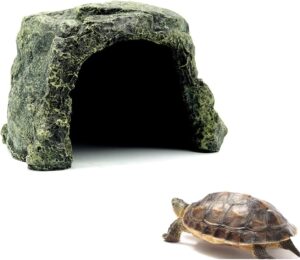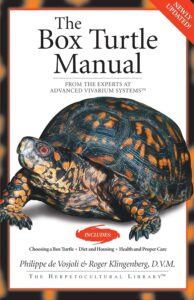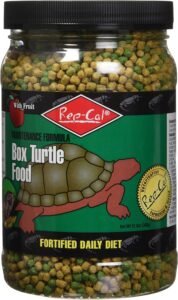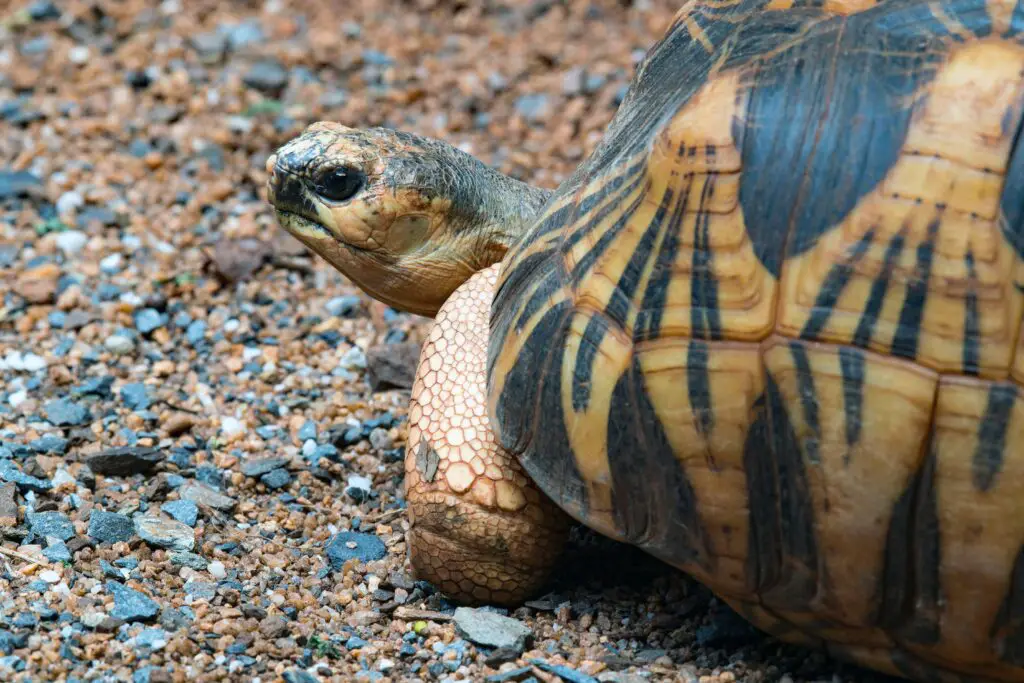Box turtle care
Box turtle care: Box turtles make fascinating and captivating pets for reptile enthusiasts. With their unique appearance, gentle nature, and long lifespan, they have become a popular choice among turtle keepers.
These remarkable creatures belong to the Terrapene genus and are native to different regions of North America. Known for their ability to retract into their shell like a box, box turtles are well-adapted for survival both on land and in water.
Brief Overview of Box Turtles as Pets
Box turtles are highly intelligent reptiles that can live up to several decades when provided with proper care. They possess a sturdy shell that acts as their primary defense mechanism against predators, allowing them to retreat into it and close it tightly when threatened.
Their shells come in various colors and patterns, making each individual turtle unique. When considering box turtle ownership, it is important to note that there are several species within the Terrapene genus.
The most common ones kept as pets include the Eastern box turtle (Terrapene carolina carolina), Western box turtle (Terrapene ornata), Three-toed box turtle (Terrapene carolina triunguis), and Gulf Coast box turtle (Terrapene carolina major). Each species has its own specific care requirements; thus, it is vital to research the particular needs of the species you intend to keep.
Importance of Proper Care and Maintenance
 Taking proper care of a box turtle is not just crucial for its wellbeing but also for ensuring your enjoyment as a pet owner. By providing adequate care, you create an environment that promotes good health, longevity, and overall happiness for your shelled companion. Maintaining suitable housing conditions with appropriate temperature ranges helps mimic the natural habitat of these turtles.
Taking proper care of a box turtle is not just crucial for its wellbeing but also for ensuring your enjoyment as a pet owner. By providing adequate care, you create an environment that promotes good health, longevity, and overall happiness for your shelled companion. Maintaining suitable housing conditions with appropriate temperature ranges helps mimic the natural habitat of these turtles.
A well-balanced diet, including protein sources, vegetables, fruits, and calcium supplements, ensures their nutritional needs are met. Regular access to fresh water for drinking and soaking also plays a significant role in their overall health.
Furthermore, proper care and maintenance involve creating opportunities for exercise and enrichment to keep box turtles mentally stimulated. Providing both physical space for exploration and environmental enrichment such as hiding spots, climbing structures, and interactive toys can enhance their quality of life.
Housing and Enclosure
Size requirements based on turtle’s age and species
The size of the housing and enclosure for your box turtle should be determined by its age and species. As hatchlings, box turtles are tiny and delicate, requiring a small space to prevent them from feeling overwhelmed.
However, as they grow, they will need larger accommodations to thrive. A general rule of thumb is to provide at least 10 gallons of space per inch of shell length for adult turtles.
For example, if you have a 6-inch box turtle, the enclosure should be around 60 gallons in size. Different species of box turtles may have varying space requirements due to their natural habitat preferences.
Some species are more terrestrial while others are semi-aquatic. It is crucial to research your specific turtle’s needs to ensure it has enough room to move around comfortably.
Indoor vs outdoor enclosures
 When considering the type of enclosure for your box turtle, you must weigh the advantages and disadvantages of indoor versus outdoor setups. Indoor enclosures offer several benefits. They provide better control over environmental conditions such as temperature and humidity levels since they are not subject to external weather changes.
When considering the type of enclosure for your box turtle, you must weigh the advantages and disadvantages of indoor versus outdoor setups. Indoor enclosures offer several benefits. They provide better control over environmental conditions such as temperature and humidity levels since they are not subject to external weather changes.
Indoor enclosures also protect your turtle from potential predators or exposure to harmful elements like extreme weather conditions or parasites found outdoors. On the other hand, outdoor enclosures can offer a more natural setting for your box turtle with access to direct sunlight, fresh air, and a variety of plants.
This exposure can help promote physical well-being and stimulate natural behaviors in the turtle. However, it is essential to ensure that the outdoor enclosure is predator-proofed and meets all necessary safety requirements.
Tips for creating a suitable habitat within an enclosure
To create an ideal habitat within an indoor or outdoor enclosure for your box turtle, there are several key factors that need to be considered. First, ensure that there is enough space for your turtle to move around freely and exhibit natural behaviors. Incorporate a combination of hiding spots, such as rocks, logs, or plants, to provide a sense of security and mimic their natural environment.
Next, provide different substrates in the enclosure that can accommodate burrowing behavior. Options like soil mixed with coconut fiber or cypress mulch work well for box turtles.
Avoid using cedar or pine substrates as they can be toxic to turtles. Maintaining appropriate temperature and humidity levels is crucial for the well-being of your box turtle.
Use heat lamps or heating pads in specific areas to create temperature gradients within the enclosure. Also, consider installing a reliable hygrometer to monitor humidity levels, which should generally range between 50-70%.
Enrich the enclosure with various natural elements like rocks, branches, and plants. These additions not only provide climbing opportunities but also create hiding spots and encourage exploration.
Remember to choose non-toxic plant species suitable for box turtles. By carefully considering size requirements based on age and species, weighing indoor vs outdoor options, and implementing tips for creating a suitable habitat within an enclosure, you can ensure your box turtle has a comfortable home where it can thrive both physically and mentally.
Temperature and Lighting
Optimal temperature range for box turtles
Box turtles are ectothermic creatures, meaning they rely on external heat sources to regulate their body temperature. Maintaining an optimal temperature range is crucial for their overall health and well-being.
The ideal temperature for most box turtle species falls between 75-85 degrees Fahrenheit (24-29 degrees Celsius) during the day, with a slight drop at night. It is essential to provide a thermal gradient within the enclosure, allowing the turtle to move freely between warmer and cooler areas as per its preference.
Providing a basking area with a heat source
One of the primary requirements in a box turtle’s habitat is a designated basking area where they can comfortably raise their body temperature. This spot should be heated to approximately 85-90 degrees Fahrenheit (29-32 degrees Celsius) using an appropriate heat source such as a heat lamp or ceramic heater.
A flat rock or log can be placed under the heat source to serve as a basking surface. Ensure that the basking area is large enough for the turtle to fully extend its limbs and absorb warmth effectively.
Use of thermometers to monitor temperature levels
To maintain an accurately regulated environment, it’s vital to measure and monitor temperatures within the turtle’s enclosure using thermometers. Place one thermometer in the warmest part of the enclosure, particularly near the basking area, and another in a cooler section.
This allows you to ensure that both ends of the thermal gradient are within acceptable limits for your box turtle species. Regularly check these readings throughout different times of day as well as seasons, adjusting heating sources accordingly if needed.
Importance of UVB lighting for vitamin D synthesis
Recommended UVB bulbs and their placement in the enclosure
UVB lighting plays a critical role in the health of box turtles as it enables them to synthesize vitamin D3, essential for calcium absorption and overall bone health. It is recommended to use a high-quality UVB bulb specifically designed for reptiles.
These bulbs emit UVB rays necessary for vitamin D synthesis while also providing UVA rays that promote natural behaviors and overall well-being. Place the UVB bulb above the basking area, ensuring that it is within a suitable distance specified by the manufacturer to provide adequate exposure without causing harm.
Setting up a light cycle to mimic natural daylight patterns
 In addition to providing UVB lighting, establishing a proper light cycle simulating natural daylight patterns is crucial for maintaining a healthy circadian rhythm in box turtles. Mimic their natural habitat by using timers to regulate day and night periods consistently.
In addition to providing UVB lighting, establishing a proper light cycle simulating natural daylight patterns is crucial for maintaining a healthy circadian rhythm in box turtles. Mimic their natural habitat by using timers to regulate day and night periods consistently.
The light cycle should consist of approximately 12-14 hours of daytime illumination followed by 10-12 hours of darkness during nighttime. This replication of their native environment helps maintain normal biological functions, including feeding, activity levels, and overall physiological well-being.
By ensuring optimal temperature ranges and providing appropriate UVB lighting with an ideal light cycle, you can create an environment that supports your box turtle’s physical and behavioral needs. Remember to regularly monitor temperatures using thermometers and periodically replace UVB bulbs according to manufacturer recommendations to ensure your beloved box turtle thrives under these vital conditions.
Diet and Nutrition
Overview of a Well-Balanced Diet for Box Turtles
A proper diet is crucial to ensure the health and wellbeing of your box turtle. These remarkable creatures require a well-balanced mix of protein, vegetables, fruits, and calcium sources to meet their nutritional needs. The right combination of these components will provide the necessary vitamins, minerals, and energy for your turtle’s growth and vitality.
Box turtles are omnivorous, which means they consume both plant material and animal protein. Their diet should consist of approximately 50% plant matter and 50% animal-based foods.
This balance ensures that they receive essential nutrients from both sources. Providing a varied diet mimics their natural feeding habits in the wild, promoting optimal health.
Specific Food Items Suitable for Box Turtles
When it comes to protein sources for box turtles, options abound. Insects such as crickets, mealworms, waxworms, and earthworms are excellent choices. These can be purchased from pet stores or even gathered from your own garden (ensuring they haven’t been exposed to pesticides).
You can also offer cooked lean meats like chicken or turkey in small portions as an occasional treat. Vegetables play a vital role in providing essential vitamins and fiber for box turtles.
Dark leafy greens like kale, collard greens, mustard greens, and dandelion greens are highly nutritious options. Carrots provide beta-carotene while squash offers various vitamins like A and C. Be sure to chop vegetables into appropriate sizes for easy consumption.
Fruits can be given in moderation due to their higher sugar content but still provide valuable nutrients. Berries such as strawberries or blueberries are packed with antioxidants while melons offer hydration along with vitamins A and C. Apples can also be included occasionally; however, remove any seeds as they can be toxic to turtles.
By offering a well-rounded diet consisting of protein sources, a variety of vegetables, and occasional fruits, you will provide your box turtle with the nutrition it needs to thrive. Remember to vary their diet periodically and ensure that all food items are fresh and free from pesticides to safeguard their health.

Importance of Regular Cleaning to Prevent Bacterial Growth
How to take care of a box turtle: Maintaining a clean and hygienic water source is vital for the health of your box turtle. Without proper cleaning, bacterial growth can occur, leading to various health issues for your pet.
Bacteria thrive in dirty water and can cause shell infections, respiratory problems, eye infections, or general malaise. To prevent bacterial growth, it is recommended to clean the water dish thoroughly at least once a day.
Use hot water and a mild detergent to scrub away any debris or residue. Rinse the dish thoroughly to remove any soap residue before refilling it with fresh, clean water.
Additionally, regularly inspecting the enclosure for feces or other waste materials will help maintain a healthy environment for your box turtle. Promptly removing any waste will reduce potential contamination and minimize the risk of bacterial growth in both the water source and the enclosure as a whole.
Remember that proper hydration plays a crucial role in maintaining your box turtle’s overall health and well-being. By providing fresh drinking water at all times, establishing an appropriate soaking area, and ensuring regular cleaning practices are followed diligently, you can create an optimal habitat that promotes good hydration and reduces the risk of bacterial infections in your beloved box turtle companion.
Exercise and Enrichment
Providing Ample Space for Exploration
Box turtles are naturally curious and active creatures, so it is essential to provide them with enough space to explore and roam around. The size of their enclosure should be spacious, taking into account the turtle’s age and species. A general rule of thumb is that the enclosure should be at least four times the length of the turtle’s shell.
This allows for ample movement as well as areas for different activities. In addition to the primary living area, consider creating separate sections within the enclosure that mimic various natural habitats such as a grassy patch or a rocky terrain.
These diverse environments encourage the turtle’s natural behaviors and stimulate their senses. You can use non-toxic plants, logs, rocks, or even shallow water features to create visual interest and opportunities for exploration.
Encouraging Natural Behaviors through Environmental Enrichment
Environmental enrichment is crucial for box turtles’ overall well-being and mental stimulation. By providing opportunities for engaging in their innate behaviors, you can ensure that they lead happy and fulfilled lives. Consider incorporating various enrichment items into their habitat:
Hiding spots: Place hollow logs or large stones in the enclosure to create safe hideaways where turtles can retreat when they feel stressed or want privacy.
Foraging opportunities: Scatter food items across different areas of the enclosure to mimic natural scavenging behavior. This encourages them to actively search for food while providing mental stimulation.
Climbing structures: Adding branches or ramps allows box turtles to exercise their climbing abilities, mimicking their behavior in nature where they often seek elevated positions to bask or find food.
Novel objects: Introducing safe toys or objects like shells, balls, or puzzle feeders can pique their curiosity and provide mental challenges. By implementing these enrichment strategies within your box turtle’s environment, you can ensure their physical and mental well-being and enhance their overall quality of life.
To sum up how to take care of a box turtle:
Taking care of a box turtle requires careful attention to their housing, temperature, diet, hydration, and exercise. Providing a suitable enclosure that allows for exploration and mimics natural habitats is vital. Additionally, incorporating various environmental enrichment items stimulates their natural behaviors and promotes overall wellness.
Remember that box turtles are long-lived creatures that require commitment and dedication. By following the guidance provided in this article, you can provide your box turtle with the necessary care they need to thrive.
Embrace the joy of observing these incredible reptiles as they exhibit their natural instincts in a well-designed habitat. With proper care and enrichment, your box turtle companion will lead a fulfilling life while bringing joy into yours.
Further Reading
How To Keep My Turtle Tank From Smelling
How To Decorate a Turtle Tank: DIY Guide


